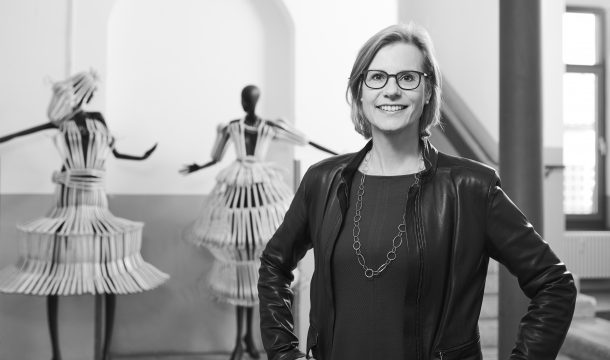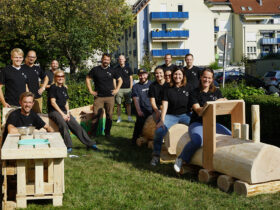An interview with Bettina Zimmermann*, Business Field Manager Retail & Interiors and COO at Ganter.
For a long time, it has been clear that digitalisation would not stop in the world of retail. But how is it already affecting traditional retail, and what kinds of scenarios can we expect to see in the future? Will we soon be looking at ourselves in talking mirrors and be served by robots?
It’s hard to say for the retail business as a whole. Depending on the industry and market segment, digitalisation is having different effects and to different degrees. In the retail trade in general, lots of energy is poured into measuring customer footfall and behaviour, collecting data and evaluating this data to provide new findings. Digital touchpoints – apps for mobile devices, as well as tablets and monitors in store to provide ‘digital shelf extensions’ – also facilitate a stronger interaction with the end consumers. With click and collect, i.e. ordering online and picking up items from a local store, it is possible to attract (new) customers to the shop and potentially generate additional sales, thus blurring the lines between online and offline retail.
Ideally, using the various sales channels simultaneously increases the end consumer’s loyalty to the retail brand. At the same time, this reveals a lot of the end consumer’s data, which provides information about their preferences and behaviours. This helps the retailer and brand to tailor both their service and products to the target group more quickly and precisely – not only on the online platform but also in its traditional retail outlets. Data collection also occurs in the background at self-service checkouts, some of which are already installed in shops and major sports outlets. These days, no one wonders at the customised ads that pop up when they’re online because they used a standard search engine the day before to research a new bike.
Making this customer data useful for traditional retail will be one of the biggest challenges facing us in the future. The digital mirrors that briefly caused such a stir have not, however, become commonplace in the fashion industry – as far as I can tell. The investments seem to be too big compared to the expected added value as a result. In fashion retail in particular, it is widely recognised that one-to-one advice by the in-store staff is what makes the difference compared with online shopping, and that traditional retail needs to make the most of the advantages offered by this advisory service, combined with a range that is tailored precisely to the target group.
In food retail, the concepts go even further. Ordering food for home delivery via an app is something that many retailers now offer, and pilot projects in the USA show where this could lead. Aided by what is known as beacon technology, the Internet of Things (IoT) and sensors integrated in lights, it is now possible, for example, to actually guide the customer around the shop to the products that are on their digital shopping list. This means that the physical path of the customer through the shop is in fact digitally guided – which also provides useful information for analysing customer behaviour. I am sure that there will soon no longer be the kinds of checkout that we are used to. Payment by smartphone will completely replace them.
What trends are currently taking effect in retail besides digitalisation? Are there new sales concepts, perhaps different ones in Germany, Europe or the rest of the world?
Retail in general is on the lookout for the right formats, across all segments, everywhere. Lots of ideas are being tested, such as in Holland, where a new MediaMarkt consumer electronics concept is being tested. While MediaMarkt stores used to be seen as unappealing discount shops offering lots of goods and little interaction, this is set to change in the future. The prototype concept will present the kitchen goods available in a new integrated bistro, for example. There are also comfortable seating arrangements where new games consoles can be properly tested. Another format includes pop-up stores. Here, the store tests whether a product or brand will be successful in a new environment or in a new market before committing to the long-term rental and outfitting of a retail space. We have already created such high-end popups for Manolo Blahnik and Louboutin in the Middle East. The top dogs of retail, such as Engelhorn and L&T, are currently making big investments in integrating event spaces, catering and themed spaces. At L&T, a sports retailer in Osnabrück, the customer cannot only enjoy indoor surfing – they can also simulate altitude training in the store’s very own gym. The aim of these kinds of measures and services is to increase the amount of time the customer spends in store and to increase their purchasing potential. Whether this actually does increase sales remains to be seen. However, what is already certain is the increased importance of staff who are really in a position to be able to offer one-to-one advice to the customer and build up a relationship with them. This is the clear advantage over online retail in terms of added value, which is why many retailers are investing in extensive training and specialised deployment of staff. Both nationally and internationally, the expansion of retail space has slowed compared with five years ago. The number of shopping centres up for development has also drastically reduced and free-standing shops in premium locations are often relocated and downsized in order to minimise overheads. Premium department stores such as the KaDeWe Group in Germany and international department stores appear to be bucking this trend,enabling them to create high-quality options for showcasing their premium and luxury brands within large retail spaces. Harrods and Selfridges in London, Galeries Lafayette, Printemps and Le Bon Marché in Paris, La Rinascente in Rome and de Bijenkorf in the Netherlands, etc. – they all pursue a similar strategy and often benefit from their prestigious historical buildings – architectural highlights that attract even more visitors to what are already tourist hotspots. I’m excited to see which strategy Signa Holding will pursue after the merger of Kaufhof and Karstadt. Maybe they will develop a completely new urban format with sales floors, office space and living areas, all in one and the same building? And while less space is being dedicated to fashion in premium locations – as we have seen – other sectors are starting to dominate our shopping streets. Car showrooms offering new e-mobility and brand shops for paints, such as Craig & Rose, are opening their own shops, while IKEA is starting to develop inner-city stores and even food retail is returning, often accompanied by cookery events and the like. Even the big hitters of online retail have understood that the most important factor these days is multi-channel retail. This is why Amazon has opened its own book shops, and Mr. Spex, which was previously an online optician’s, now has ‘real’ stores, where customers can find all the models that they are familiar with from the website – with the decisive advantage that they can actually hold the glasses themselves and try them on. For us, as shopfitters, the fact that shopping is now done both online and offline makes almost no difference to the technical challenges and implementation of our work.
Even if multi-channel retail doesn’t pose any immediate challenge to us, what developments do you expect to see in terms of shopfitting? Are there any new materials or systems in the pipeline?
Flexibility is a major topic in fashion and sports retail. The fittings and furniture need to be able to be rebuilt or rolled away quickly in order to create space for events. Because shops are increasingly using nearby warehouses in order to get away with reduced inventory in the shop, fewer walls are required with system rails and display options. In the premium and luxury segment, customisation is already king – with each brand already trying to underline its core message through its retail concept. Popular materials remain natural stone in all its variations, brass, stainless steel and velvet for seating. While it is now rarer to see high-gloss finishes, which were en vogue for a long time, natural, solid wood is much more popular. And it’s hard to imagine shops these days without coffee bars, sofas and individually curated merchandising. Shops are increasingly becoming meeting places, event locations and themed areas.
In other business segments, it is clear that customers are becoming increasingly sensitive to the topic of sustainability. Have you also determined the same shift in the world of retail?
Unfortunately, this is hardly true or completely untrue of shopfitting and furniture manufacturing. There’s certainly a bit of greenwashing, but it’s only really taken seriously where the topics of the environment and sustainability are intrinsically associated with the brand, such as with Hess Natur or Alnatura. However, if sustainable behaviours are good for the wallet then everyone starts to get behind them. In this way, most people have switched over to LEDs in order to minimise running costs. In contrast to shopfitting and merchandising, however, the topic of the environment is playing a bigger and bigger role in the brand products themselves. We are particularly aware of this in our product development business unit (see also page 40 et seq), where we receive more and more enquiries about sustainable materials.
Would you like to say a little about your favourite projects of 2018, or about internal developments?
It would be hard to pick just one from all the different retail projects we completed over the past year. Instead, I would like to take this opportunity to emphasise that we don’t just focus on retail space in our Retail & Interiors segment, but we’ve also taken on all kinds of demanding developments in a wide range of sectors. That’s why we take such a broad approach to project and client acquisition and approach a wide range of different international interior architects, designers and building architects. At Ganter itself, we are working more and more closely with the Product Design and Procurement division. I think there’s great potential for Ganter in this collaboration.
*The qualified architect Bettina Zimmermann began her career at Ganter as a freelancer in 2003, assuming responsibility for clients such as Betty Barclay, Breuninger and Porsche Design. In 2005, she took on a permanent position at the company as a project manager. Just one year later, she was appointed as a key account manager. In 2008, Zimmermann began to manage her own unit, taking on responsibility for key clients such as Escada, de Beers, Vertu, Montblanc and other major brands. The 57-yearold has been leading this important business unit very successfully for several years now. Since becoming a managing director in 2014, she has been responsible for the Ganter Group’s Retail & Interiors segment.



